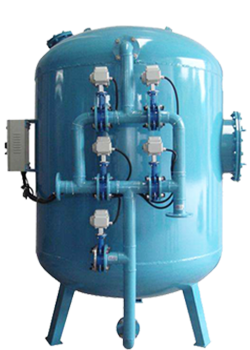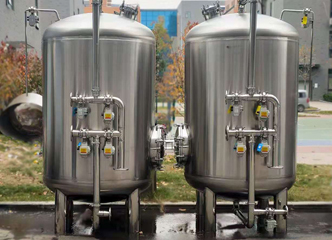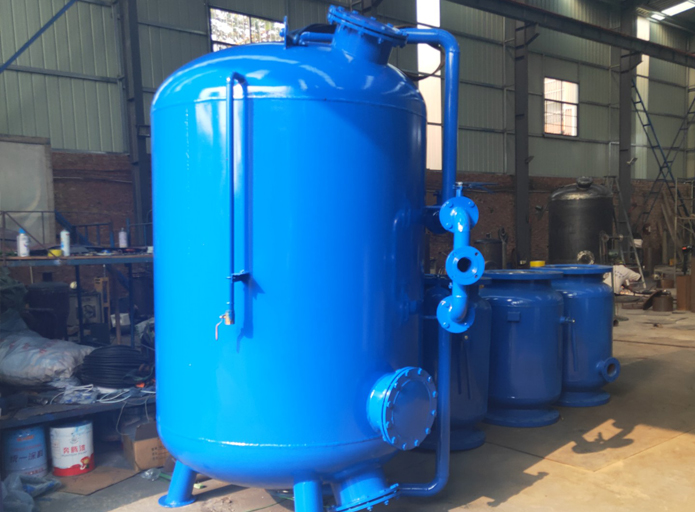In the paper industry, activated carbon filters play a very important role. Below I will explain to you in detail the specific application of activated carbon filters in the paper industry:
First of all, we need to understand that the paper industry consumes a lot of water during the production process and generates a large amount of wastewater during the production process. If these wastewaters are discharged into the environment without treatment, they will cause serious pollution to water resources and the environment.
In this case, activated carbon filter plays its role. The activated carbon filter can not only effectively filter and purify the water source drawn from the factory, remove impurities and pollutants in it, and ensure that the water quality meets production needs, but it can also treat wastewater generated during the papermaking process.
In wastewater treatment, activated carbon filters can absorb organic impurities, pigments, odors, etc. in wastewater, significantly improving water cleanliness. More importantly, the wastewater treated by the activated carbon filter can be reused in paper production, realizing the recycling of water resources. This not only greatly reduces the factory's demand for water resources and papermaking costs, but also protects water resources and reduces the impact on the environment.
Moreover, activated carbon filters are usually equipped with automatic cleaning systems, which can operate stably for a long time, reduce manual maintenance, and save operating costs.
In addition, I would like to emphasize that in addition to the paper industry, activated carbon filters are also widely used in many fields such as food and beverage, electronics industry, chemical industry, etc. They are currently a common and effective water treatment equipment.
In general, the application of activated carbon filters in the paper industry provides enterprises with an economical and environmentally friendly wastewater treatment solution, and has been widely used and praised.

How activated carbon filters work requires first understanding the basic properties of activated carbon. Activated carbon is a kind of fine carbon particles, which has a large area of flat surface and many tiny pores, and these pores are the source of the strong adsorption capacity of activated carbon.
Now let’s break down how activated carbon filters work in more detail:
Primary adsorption stage: When water passes through the activated carbon filter, the micropores on the activated carbon can absorb impurities in the water, including organic substances, heavy metal ions, residual chlorine and other pollutants. At this stage, the adsorption effect of activated carbon capillary pores is very high. They can adsorb larger particles to form physical adsorption, and they can also adsorb some chemical substances to form chemical adsorption.
Equilibrium stage: After being used for a period of time, a layer of balanced surface concentration is formed on the surface of activated carbon, and the adsorption continuity on the surface decreases. At this time, more adsorption occurs inside the activated carbon particles, that is, in the micropores.
Later adsorption stage: As the use time increases, the adsorption capacity of activated carbon will weaken to varying degrees, and the adsorption effect will decrease. At this time, thermal regeneration or chemical regeneration methods are needed to restore its adsorption capacity.
Thermal regeneration or chemical regeneration: Activated carbon can be regenerated through thermal regeneration or chemical agents to restore the adsorption capacity of activated carbon. Thermal regeneration uses high temperature to evaporate the adsorbed substances in activated carbon, while chemical regeneration restores the adsorption capacity of activated carbon through chemical reactions.
It is worth noting that the size of activated carbon particles also affects adsorption capacity. Generally speaking, the smaller the activated carbon particles, the larger the filtration area and the higher the adsorption efficiency.
Generally speaking, the working principle of activated carbon filters is to purify water by utilizing the strong adsorption capacity of activated carbon to adsorb various impurities and harmful substances in the water. This method can not only effectively solve water quality problems, but also realize the recycling of water resources, greatly reducing the waste of water resources. At the same time, this working method also ensures the efficient operation and service life of the filter.
As a common and effective water treatment equipment, activated carbon filters have many obvious advantages due to their special physical filtration and chemical adsorption characteristics:
Excellent removal ability: Activated carbon filter can effectively remove organic matter, odor, color, residual chlorine and heavy metal ions in water. It not only has excellent removal effect on harmful substances in water, but also has good removal effect on some small molecular organic matter and other pollutants.
Protect subsequent equipment: Professionally designed activated carbon filters can adsorb residual chlorine that cannot be removed in the pre-filtration, thereby protecting subsequent equipment (such as reverse osmosis membranes, ion exchange resins, etc.) from oxidative degradation and extending the service life of the devices.
Excellent filtration efficiency: Activated carbon has a large specific surface area and developed void structure, giving it strong adsorption capacity. The porous internal structure makes the filter have high filtration efficiency, can quickly absorb various harmful gases, and also has good filtration effect on tiny particles and microorganisms.
Reduce COD (Chemical Oxygen Demand): Activated carbon filters can effectively reduce the COD value in water, improve water quality, and make the effluent cleaner and safer.
Provide a safe and clean water source: Activated carbon filters can also effectively prevent and reduce the inflow of harmful substances, providing a safer and cleaner water source.
Acid, alkali and salt resistance: Activated carbon filters have strong acid, alkali and salt resistance, making the filter equipment more adaptable to various usage environments and enhancing the stability and reliability of the equipment.
Environmental protection, no secondary pollution: Activated carbon filters use physical adsorption to treat water quality without adding any chemicals, without secondary pollution, and protect the environment.
Low pressure difference and low energy consumption: Due to the advantages of the structure of the activated carbon filter itself, the pressure difference during its working process is small and energy consumption is low, thereby reducing operating costs.
Long service life: Activated carbon filters have a long service life. They only need regular maintenance and replacement of activated carbon, which can be used for a long time and reduce the cost of use.
Stable water purification effect: After long-term use, the water purification effect of the activated carbon filter remains stable, achieving the goal of long-term removal of impurities and harmful substances in the water.
In general, activated carbon filter is an efficient, environmentally friendly, economical and practical water treatment equipment, which has a wide range of application prospects in both households and industries.

Activated carbon filter is a common water treatment equipment with simple structure and easy operation. This filter mainly consists of the following parts:
Tank body: The tank body is generally made of materials with high pressure resistance and hardness (such as stainless steel), and is usually cylindrical in shape. The inside of the tank is filled with activated carbon, which is responsible for adsorbing and filtering harmful substances in the water.
Upper and lower heads: The upper and lower heads are installed on the upper and lower ends of the tank respectively, closing the entire tank.
Water inlet and outlet: This is the path that water takes to enter and exit the filter. The water inlet is usually located on the upper head. After the water is filtered by activated carbon, clean water will flow out from the outlet of the lower head.
Filter: The filter is usually located at the water inlet and outlet to intercept larger impurities and prevent them from passing directly through the filter.
Internal filler: Activated carbon is the main filler of the filter. It has a large specific surface area and a developed void structure, giving it strong adsorption capacity. Some filters will also add coal, coconut shell, nut shell and synthetic carbon as needed to meet different filtration needs.
Base: The base provides stable support for the filter, keeping it in a stable position during use.
For further control or regulation of the filtration process, some activated carbon filters may also be equipped with controllers or other ancillary equipment. It is worth noting that the specific construction of activated carbon filters may change based on different uses and design requirements.
The filling inside the activated carbon filter is mainly activated carbon. Because of its large specific surface area and developed pore structure, activated carbon can effectively absorb free matter, microorganisms, some heavy metal ions, etc. in the water, thereby cleaning and improving water quality.
At the same time, depending on specific filtration needs, activated carbon filters may also have some other types of fillers added:
Coal-based activated carbon: Coal-based activated carbon usually has high hardness and anti-wear ability, and can be suitable for filtration of some water sources with high flow rate and high turbidity.
Coconut shell activated carbon: Coconut shell activated carbon is a high-quality activated carbon that has excellent performance in removing colored substances and organic substances, and adjusting the pH value of water quality.
Nutshell activated carbon: Nutshell activated carbon has good biocompatibility and environmental protection, and is often used for safe filtration of food and drinking water.
Synthetic carbon: This type of material can also be used as a filler for activated carbon filters, helping to improve the filter's adsorption capacity and filtration effect.
However, it should be noted that the selection and combination of activated carbon filter fillings need to be customized and selected based on specific filtration needs and water source conditions.

When selecting activated carbon filter filling, you need to consider the following aspects based on actual needs and usage conditions:
Seeking efficient adsorption performance: Choosing activated carbon with strong adsorption capacity and fast adsorption speed is the core element of selecting fillers. Some high-quality activated carbon varieties, such as coal-based activated carbon, coconut shell activated carbon and some fruit shell activated carbon, can effectively absorb free matter, microorganisms and some heavy metal ions in filtered water.
Consider the mechanical strength of the filter material: Under the action of flowing water flow, the filter material may be broken due to impact and wear between particles. This requires the selection of activated carbon with high mechanical strength that can resist breakage and wear.
Meet specific filtration needs: Choose the appropriate activated carbon based on the type of material you need to filter. For example, if you need to remove specific substances such as heavy metal ions, organic matter, and residual chlorine, you need to choose activated carbon varieties with special adsorption properties for these substances.
Consider water quality conditions: The pH value, temperature, hardness, turbidity and other parameters of the water source are also important reference factors for selecting activated carbon. For example, when treating water sources with high turbidity, coal-based activated carbon may be needed.
Choose affordable filter media: The price and service life of the filter media also need to be taken into consideration. Ideally, you should choose activated carbon varieties with high cost performance and long service life.
Filling method and sequence: Regarding the filling method, you can choose activated carbon granules to fill or the activated carbon to be die-cast in the filter element frame. The filling sequence should be determined according to the particle size of the filter material and its filtration capacity. Generally, coarser filter material is used in the upper part and finer filter material is filled in the lower part, so as to improve the filtration effect and the service life of the filter material.
In short, choosing the filler of an activated carbon filter is essentially to select the activated carbon variety that best meets the filtration needs and has efficient, economical and stable properties.








